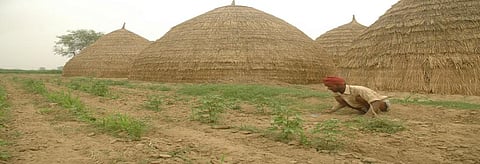Will contract farming law relieve agrarian distress?
The Union government, with its ambitious and untenable plan of doubling farmers’ income by 2022, has embarked on reforms in the farming sector, one of which is the formulation of a law on contract farming. If devised and implemented in the right way, this law could indeed alleviate some of the stresses that India’s farmers face. Studies have shown that contract farmers earn considerably more than non-contract farmers.
At present, contract farming is regulated under the Agricultural Produce Market Committees (Development and Regulation) (APMC) Act of 2003. This is the law that legalises contract farming. It mandates that private companies (sponsors) must register themselves as well as the farming contract agreements with the market committees created under the Act. Significantly, the Act provides that the sponsor cannot, at any time, lay claim to the land title of the farmer, thereby giving farmers some protection. However, these provisions are woefully inadequate. The Act does not provide for an effective monitoring mechanism, capacity building programmes or a robust dispute settlement system.
The NITI Aayog recently circulated a draft model contract farming law titled Agricultural Produce and Livestock Contract Farming (Promotion and Facilitation) Act, 2018, which proposes a comprehensive legal regime to enable contract farming. However, the draft law too suffers from some of the same deficiencies as the APMC Act. The draft says, “Contract farming is a pre-production seasonal arrangement between farmers and sponsors which transfers post-harvest market unpredictability from farmers to sponsors.” In theory, contract farming seeks to combine agriculture with corporate efficiency while ensuring the provision of inputs such as seeds and technology to the farmers.
Problems at hand
Sponsoring entities typically rely on economies of scale to achieve profit maximisation and therefore often exclude small-scale farmers. This would be untenable in the Indian context as this would exclude a majority of Indian farmers, who are small farmers, owning less than 2 hectares (ha) of land, and marginal farmers who, on an average, own 1.1 ha of land. Though the draft Act, in its preamble, recognises the precarious position of the India’s small and marginal farmers and also accepts that some form of non-coercive pooling of resources would be necessary, the draft Act itself provides no guidance on how this can be done. Further, India also has no concrete law on land pooling that would be necessary to make this law a success.
Contract farming is also known to lead to an increase in monoculture farming and a loss of crop diversity, making crops more vulnerable to destructive pests and crop diseases as only a single crop is sown to achieve efficiencies of scale. The new law must find a way to address the additional risks that contract farmers have to confront and find a way to ensure protection to farms through better fertilisers, pesticides and incentivisation. Therefore, it is imperative that the government promotes risk sharing between the contracting parties and farmers and provide easy access to non-exploitative crop insurance schemes.
Importance of safeguards
There is a great probability that the disparate bargaining power between farmers and sponsors could also lead to exploitative contracts for farmers. Although the Model Contract Farming Act provides for the setting up of “Registering and Agreement Recording Committees” where the contracts are to be registered, it does not make provisions to ensure that these committees must be staffed with legally-trained persons who must vet the contracts to ensure that no dubious or unfair clauses have been included.
Studies also show that the success of contract farming depends significantly upon the type of crops that are planted. For instance, a study conducted in Punjab that compared Basmati rice with potato yields showed that the latter had a significant yield and income advantage over the former. This was a direct result of better suitability of soil and weather conditions for potato growth in addition to better technology and supervision by the sponsors. There-fore, it is necessary that state governments do not adopt a one-size-fits-all approach, and rather promote crops that are uniquely suited to the state’s own unique soil, weather and technological conditions.
It must be noted that there are many contract farming success stories, including that of chilly and prawn farming in Andhra Pradesh and cotton farming in Tamil Nadu. Many studies by the Food and Agriculture Organization also show that contract farming can indeed benefit both parties by increasing efficiency, productivity and farmers’ income, while at the same time, giving private sponsors a greater say in farming methods, type and quality of produce.
The improved yields, greater technology transfer and market access that could potentially accrue from contract farming are advantages that will significantly benefit the Indian farmers. While contract farming, if implemented wisely, does have the potential to alleviate the suffering of India’s farmers, it is imperative that the government takes a cautious, research-backed approach rather than imposing another hasty, ill-thought-out decision that will cause more harm than good.
(The author is a research fellow with the Vidhi Centre for Legal Policy, Bengaluru)
(This article was first published in the 1-15th December issue of Down To Earth under the headline 'A deal for farmers').


